Australian Alpine Ascent Race Recap
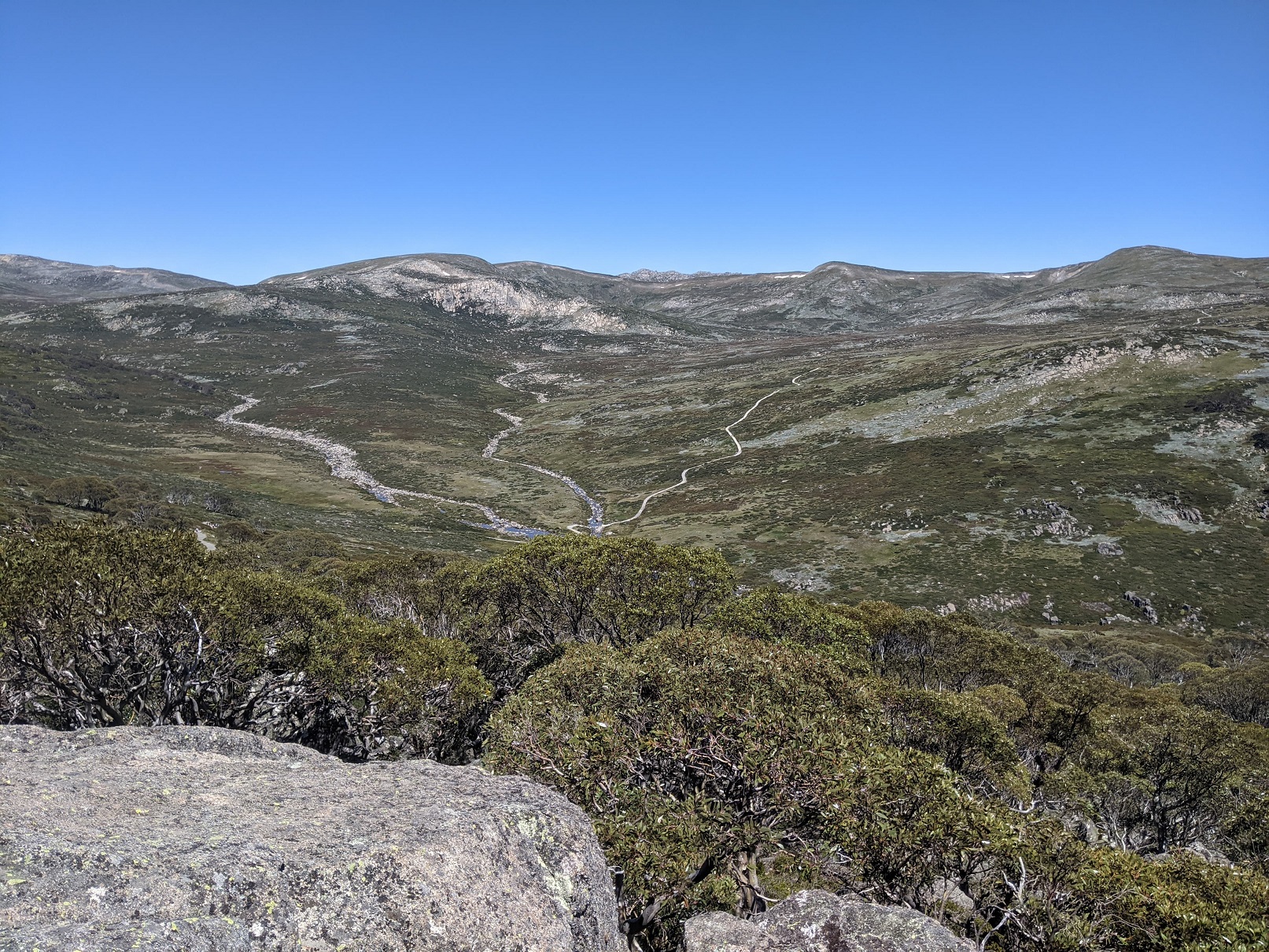
The Australian Alpine Ascent (AAA) is Australia’s highest race. Starting at Charlotte Pass and completing a loop of Main Range and Mt Kosciusko Summit, the race offers altitude (1,700-2,200m above sea level), alpine scenery and an unmatched opportunity to race through 25.7km of Kosciusko National Park. Although I raced the AAA in 2018 (I came second), I have been unable to race since then because of clashes with the Spartan National Series. However, in 2021 I decided to prioritise trail and mountain races, and so finally had the opportunity to have another go at AAA.
My race strategy was to push hard from the start, and this worked really well for the climb from Charlotte Pass village to Charlotte Pass, down to the Snowy River and up the first climb. From 5km onwards it was a tough slog (in beautiful alpine surroundings). After completing most of the climbing, there is 7km of undulating single trail around Lake Albina that joins the main fire trail up to Mt Kosciusko. I pushed harder on this section, particularly on the new board walk, and worked the climbs hard (so much so that a 50km runner I overtook asked me if I was ok haha – yes just pushing hard). After touching the Mt Kosciusko summit cairn and collecting my bracelet proving I did the up and back section, I started the 10km very hard. I passed Laura Vilcek who was in second place about 500m down and so was about 1km/5mins ahead. In my head this was not enough distance and so I hammered the first 5km of descending far too hard and then the final 5km was a crazy struggle despite being on down hill terrain. I managed to convince my quads to keep moving and I mercifully made it to the finish line, so relieved that was over. I was 9 minutes in front of second place getter Laura Vilcek, who had a very strong and consistent race. My awesome friend and running buddy Bianca Pietrass-Wong came in third.
Thanks Elite Energy for hosting such a classic alpine race. It was so great to race again and see the trail running community out in full force.
Women top 5
1. Monika Holmwood 2:26 (8 overall)
2. Laura Vilcek 2:35 (19 overall)
3. Bianca Pietrass-Wong 2:38 (25 overall)
4. Jessica Kennedy 2:44 (27 overall)
5. Emma O’Sullivan 2:48 (28 overall)
Men top 5
1. James Mason 2:09
2. James Munro 2:11
3. Tyson Flynn 2:13
4. Brad Pamp 2:17
5. Michael Howes 2:18

Snowy River crossing
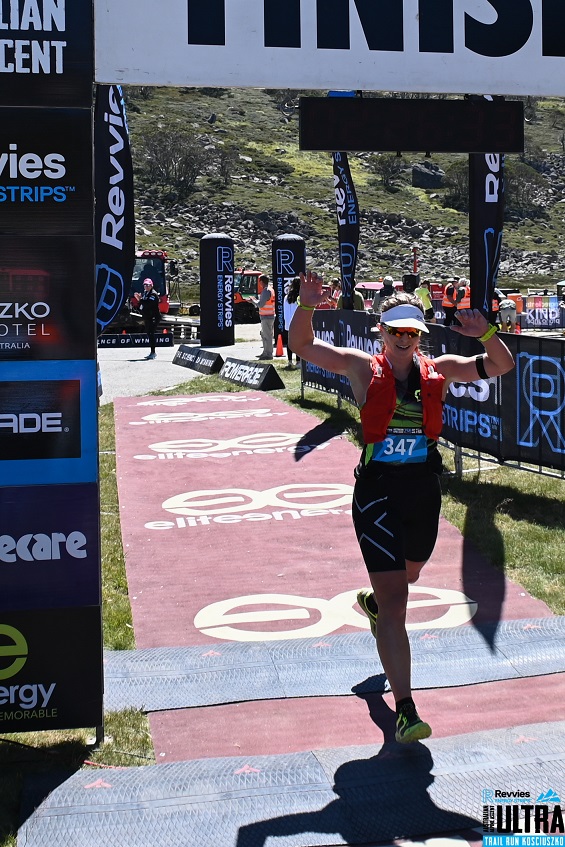
Finish line pain face.
Race report – long form
Getting an entry to the AAA was not easy
The race sold out quickly before I had planned my racing year. Unfortunately there was a change in the transfer policy that meant I could not get anyone to transfer me a tickets. After being on the waitlist for months I decided it was so unlikely I would get a ticket I entered the 10km True Grit race which was on the same day. Then two weeks before the race I miraculously received an email that I was at the top of the waiting list and could now buy a ticket to AAA. If you ever get an opportunity like that you can’t miss it. So I cancelled True Grit entry and accommodation and entered AAA. I had trained in the alps all summer and I was not missing an opportunity to put this to good use.
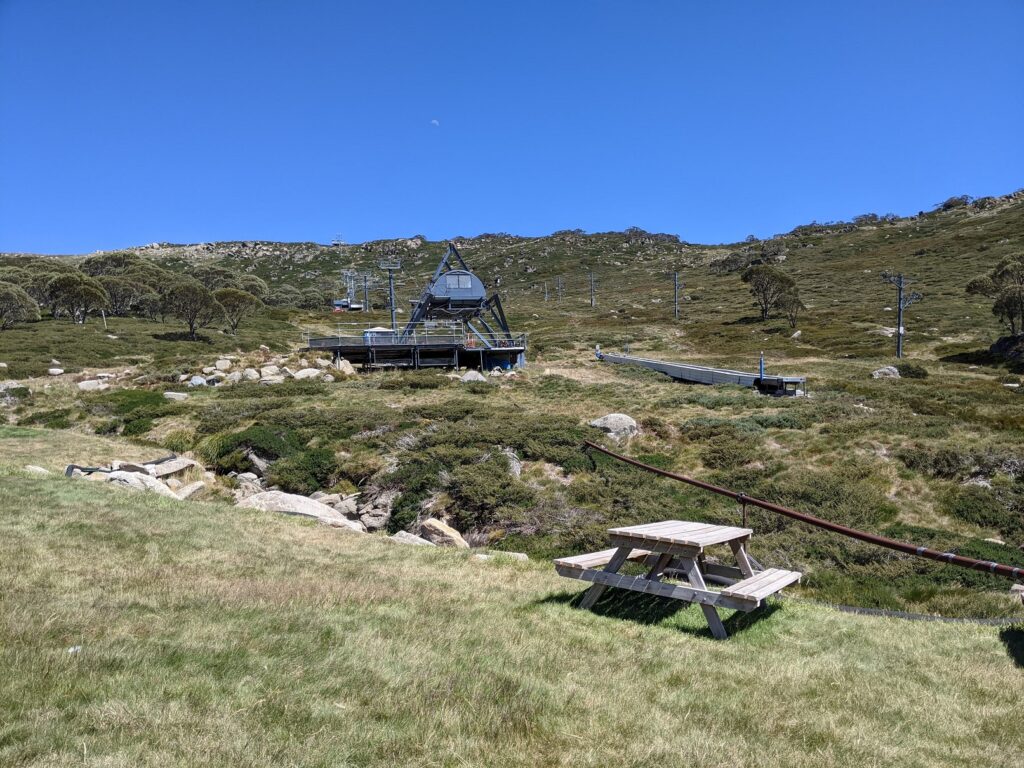
Charlotte Pass village looking up to Mt Stillwell/main range
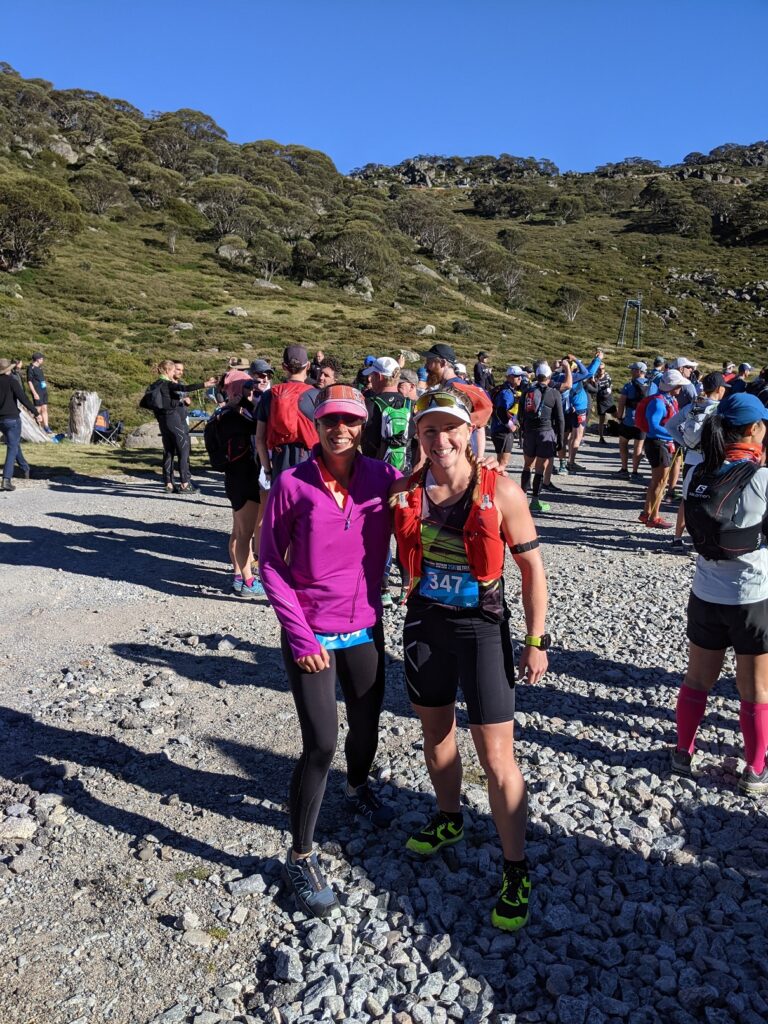
With Biance pre-race. Race start was 9:30am so there was a lot of time beforehand.
Previous AAA results
I usually don’t set goals about placings. This is because you cannot control what other people are doing. Usually my goal is to give 100% so that I finish without any regret that I could have pushed harder. If I am doing my best at every moment in the race then I am happy. But for AAA 2021, given all the alpine running I did over summer and the feeling that I might not have the opportunity to do this race again, I did set myself the goal of coming first, with the secondary goal of top 3. Living in Canberra for two out of the three past years I have had a lot of opportunity to run the main range loop in both a clockwise and anti-clockwise direction. The clockwise direction is faster because the 10km ascent at the start of the race is on well graded and gradual firetrail. In the anti-clockwise direction the ascent is over more technical trails and single trail and this takes longer. In 2018 I clocked 2:19 but this was in the clockwise faster direction. The first female clocked 2:12.
In 2019 and 2020 the course went in an anti-clockwise direction and so those times give a better indication of time required to win the female race. The best female times in 2019 and 2020 were 2:29 and 2:23 respectively. Knowing my times from running the course in training runs I thought I could hit this mark in a race.
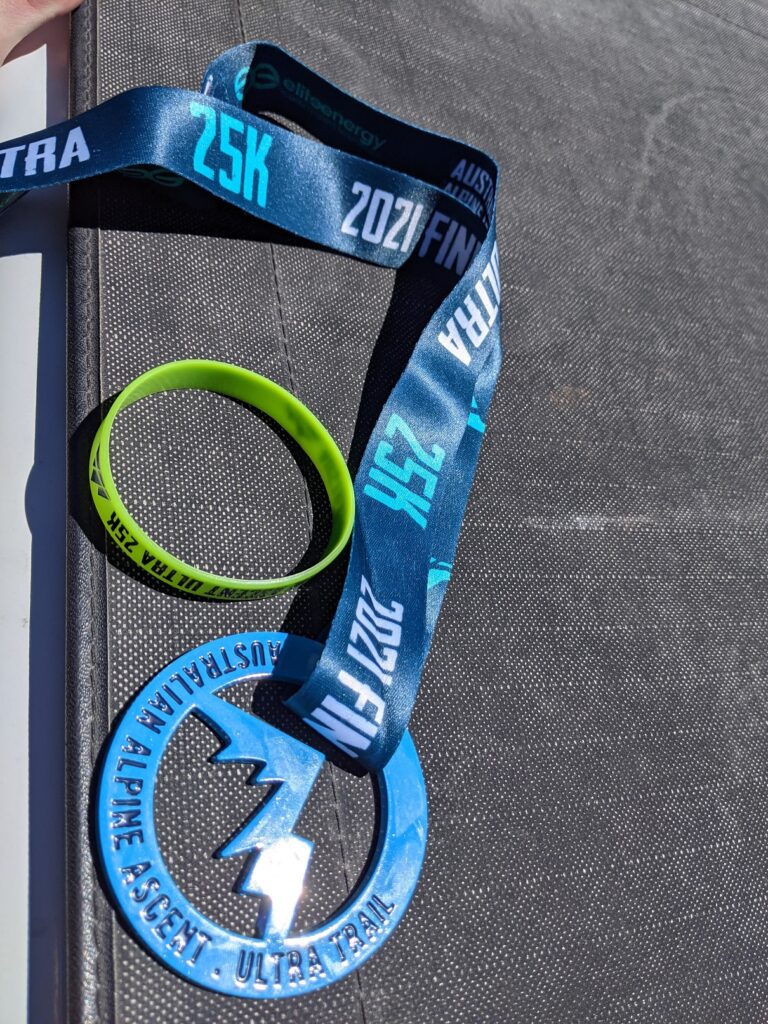
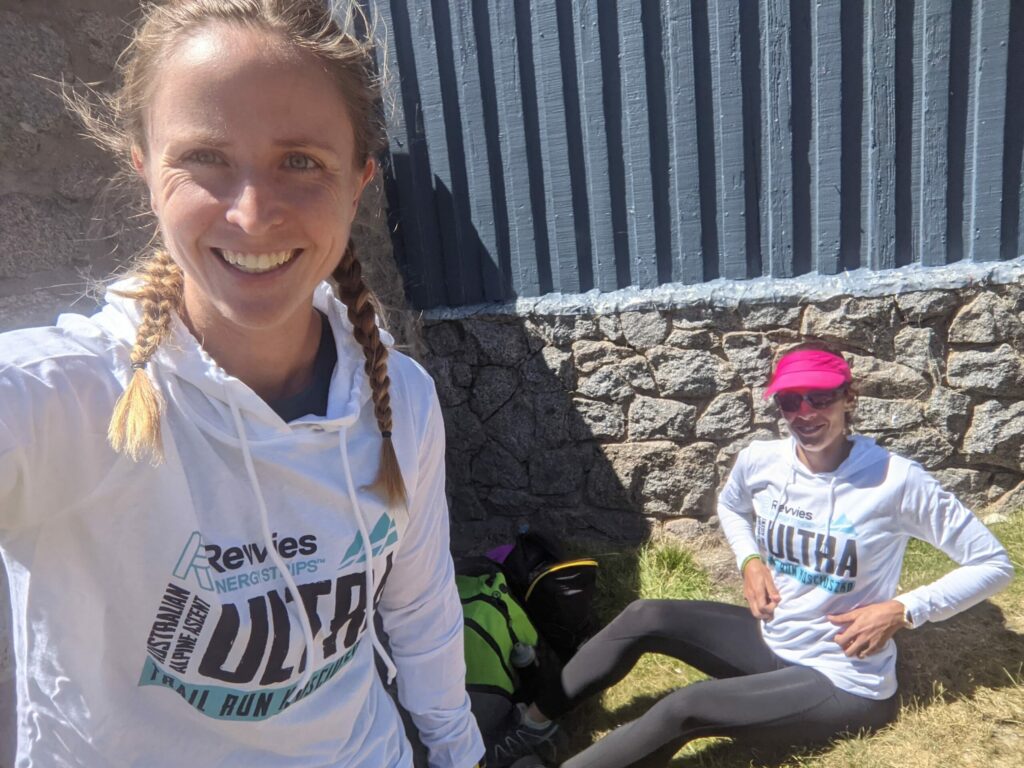
Above: Elite Energy Events always have awesome souvenir hoodies. This year they are white. How long will mine stay white?
Left: Finishing medal and the band providing you went to Mt Kosciusko summit (and did not conveniently cut off 2.5km of the course).
2021 detailed race report
The 25km didn’t start until 9:20am and so this gave us the opportunity to eat a substantial breakfast at 6am and then not rush to get to Perisher to get the event bus to the start line at Charlotte Pass. Although there were COVID-safe measures in place, the event was sold out to normal numbers and so this was my first experience being back at a ‘normal’ race. I made sure I raised my heart rate significantly in the warm up, as although I’m used to driving to altitude and running, I still need that first 15-20mins of elevated heart rate before my body adjusts. The start was as per pre-COVID with all 400+ 25km racers starting in the same group. I ran very hard up Charlotte Way and then on Kosciuszko Road. I also took the first descent down to the Snowy River hard as per my plan to get some time on the technical running. On jumping across the Snowy River there were four men in front of me, so I probably did start a bit hard. The big climb up to Blue Lake began from the river. This is a steady uphill and I ran the first part before the first flatter section hard. I then found myself sucking for air and unable to control my heart rate so I fell into this terrible pattern of running hard uphill followed by 10 steps of power hiking. I immediately felt dispirited because I ordinarily run this whole section easily (but not at race pace). I resigned myself to the fact it would be a hard day and kept pushing. What I should have done is pulled back the pace so I could keep the effort level just that bit lower and move smoothly and consistently. I wasted a lot of energy forcing the pace too hard. To win a race you just have to execute what you do in training. I was completely losing my head, leading to the run hard/walk cycle and I never do this in training. This pattern continued for the whole race. It is not something I am proud of, but I can definitely say I pushed as hard as I could. Next year I will hopefully return with the goal of running my own race ‘smooth and fast’ rather than ‘very fast mixed with hiking’. I also found I was often checking behind me. I normally don’t do this. Not only is it dangerous to twist to look around while running technical trails, I should be running my own race (except the very end it is ok to check to make sure you have picked up the pace hard enough). Anyway, by the time we reached the top of the climb and descended towards the board walk I had finally achieved smooth and fast running. The board walk is a cheese grater with serrated gridding for icy conditions. If you fall on it your race will likely be over. Unfortunately the board walk is also the most scenic part of the race, looking across Lake Albina. So the thoughts going through me head were “run fast, don’t trip on the boardwalk, but the scenery is beautiful”. Most of the time I was not looking at the scenery but concentrating on safely overtaking the large number of 50km runners on the narrow board walk. Exiting the board walk we started the most technical part of the run which is on some jagged rocks around Northcote Pass. This was fun rockhopping. Starting the final section of the single trail across Muellers Pass I again started running too hard so had to intersperse each hard running effort with some power hiking, particularly up the long stepped section. This meant that when I reached the turn off to Mt Kosciusko I was very fatigued and ran that 1km segment slower than I had a couple of weeks ago during a training run. I then panicked and on turning around from the summit took the first 5km of descending like I was doing a 5km park run time trial (4:10 pace). Passing Seaman’s Hut I felt strong and confident. By the time I got to the Snowy River crossing my quads and legs were destroyed. At the turn around I estimated I had 5 minutes on the second female at least, but I am no road runner and I had not prepared for a 10km finish of very fast descending. The result was that with 6km to go I was dead. Again, instead of slowing down and focusing on smooth and fast running, I ended up breaking the remaining distance down into 1km chunks. I ran each km as hard as I could and then let myself walk for 15 seconds. This is not what I normally do but I just couldn’t get back into my normal rhythm. It would also have been a hell of a lot more efficient and less force on the quads to run each kilometre 15 seconds slower. My average pace including the walk breaks was 4:30, so if I had removed the walk breaks and just run 4:30 pace I think this would have resulted in a much less painful and equally as fast outcome.
I was so stoked to cross the line as first female. This was a goal I had been working towards for a long time. The way I ran was not pretty but in the end I did achieve both my race plan (run hard on the technical terrain, hold on for the fast downhill) and my goal, but I did not make it easy for myself. Next race I will make sure my race plan includes ‘smooth and fast’ (which usually equals more enjoyable)!